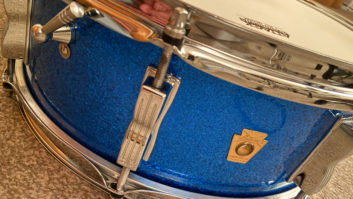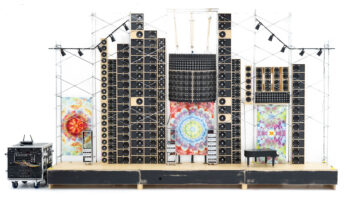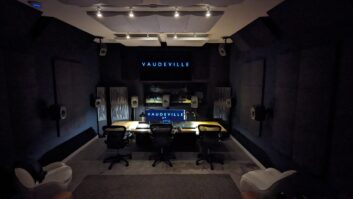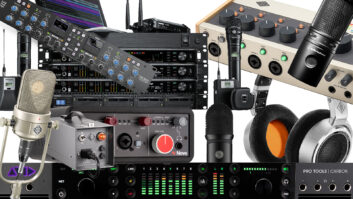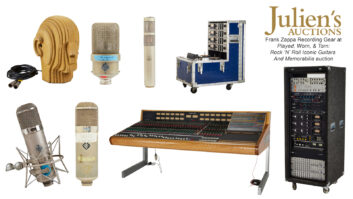
In order to survive in a post-apocalyptic world, you must be prepared. You must pack the essentials: water, matches and, of course, an SM58. Forget the Swiss Army knife. The Shure SM58 is a hammer, a weapon, a spoon, a pestle, a dildo, a scepter—and a damn good mic on just about everything.
After Armageddon, nothing will be left but cockroaches and SM58s. If you are not getting a signal out of the SM58, don’t blame the mic. These mics are so rugged they rarely fail. The only time an SM58 has ever failed me was when we accidentally blasted one with a shotgun during the recording of Tool’s Undertow album. We had miked up a couple of clunker upright pianos in the back garage at Hollywood’s Grandmaster Recorders, then proceeded to shoot them and smash them apart with sledgehammers and axes while the tape rolled. After recording, we realized that one of our mics had unfortunately been placed in the line of fire. We were in complete disbelief that the SM58 was dead. So inspired and moved by its service, we gave it an honorable burial.
Shure unveiled the SM58 in 1966 to replace the Unidyne 565, a popular mic with a hinged base that screwed securely onto the mic stand. Creating a durable mic that could be easily unclipped and carried onstage revolutionized the performances of first-generation rockers, and the introduction of the new SM58 allowed legendary singers like Roger Daltrey and Mick Jagger to get up-close and personal with their audience. The Who onstage with Daltrey swinging that mic from the end of its cable and Townshend spinning windmills with his guitar became iconic images from the remarkable ’60s rock era, made possible by the SM58.

Silversun Pickups’ Brian Aubert sings into an SM58 in concert
Photo: Paul Natkin
SHURE’S DYNAMIC DUO
The label “SM” in the SM58 and in the name of its streamlined twin, the SM57, stands for Studio Microphone. These two mics are literally identical except for the differences in the grille cover. The SM57 has a small, plastic vented cap, while the SM58 has a large, round steel-mesh cover for durability and to cut plosives and wind noise. There is a slight sonic difference between the two mics because of the shape of the caps, with the SM57 having a more pronounced low-end roll-off. The SM Series is still made today, and Shure also offers supercardioid versions with the Beta Series 57A and 58A. These are all dynamic mics needing no external power supply to operate. The price on the SM Series mics usually runs below a C-note, and because they last forever, they are often found used for half that. They are absolutely the most recognizable and most frequently imitated mics in the world. Are they also the most underappreciated mics in all of studio-dom?

Sylvia’s “special” SM57, still retaining David Bowie’s vocal spit from the Tin Machine sessions
Apparently, some studios are just too good to have either SM57s or SM58s. Once upon a time, Larrabee Sound in Los Angeles was such a place. Yes, they had AKG C 12s, Neumann U47s and U87s, and dozens of other fancy tube and condenser mics, but they were maybe just a little too snooty for these lowly Shure workhorses! So when Englishman Tim Palmer requested an SM57 for David Bowie’s vocals during the production of the first Tin Machine album—and Larrabee did not have one—I graciously offered to rent him mine for the project. I still own that Tin Machine SM57 today, but its studio use is now restricted. The mic is kept in a special bag to prevent unauthorized engineers from compromising the Bowie DNA that most certainly has been retained in its grille cap.
Their legendary longevity has raised the SM57 and SM58 to nearly cult status, with Websites and videos created to celebrate their indestructibility. But their sonic performance onstage and in the studio is where these two mics really shine. I have learned to always rely on SM57s for a number of studio jobs. On drum kits, I’ll often have one on the top of the snare and sometimes on a hi-hat to cool its attitude. On electric guitar speaker cabinets I’ll use a Shure SM57 with a Sennheiser 421. I especially like the SM57 on acoustic guitar for a woody percussive rhythm sound. And, of course, the SM58 rules for vocals, especially on screaming and effect vocals where the singer cups his hand around the grille to give it an explosive sound. Very exciting!

Roger Daltrey and Pete Townsend of The Who—longtime SM58 users
Photo: Paul Natkin
The biggest SM58 studio revelation came to me from a Smashing Pumpkins session that I engineered with producer Rick Rubin during the Adore era. Rick requested we do a blind listen test to determine which mic was best suited for Billy Corgan’s sometimes whiney vocals. We put up 14 microphones: Telefunken 251; Neumann U47, FET 47, M49, U67, U87; AKG C 12, C 12A, C 24, 414; Sennheiser 421; Oktava MK219; and a Shure SM57 and SM58. We recorded Billy singing the same verse in the song, one mic at a time. We then listened back without knowing which mic we were hearing. The unexpected winner was the SM58, followed closely by the Telefunken 251—$35,000 worth of mics in the room, and the winner was the pedestrian SM58 microphone. Who figured the hot-turkey sandwich would satisfy such a refined palette? No capers! No reduction sauce! Please!
So how do you explain the popularity of the SM58? We sometimes forget that the musician’s performance can be more important than the choice of equipment you are using to capture it. A recording microphone that is consistently good and time-tested will step out of your way as you record. The technical barriers between artist and listener become invisible. Gear matters, but performance matters more. Stop thinking so hard! It’s not about what is outside, but what is inside.
When the apocalypse comes and the dust settles, the only things left will be cockroaches, SM58s and now that I think about it, probably Keith Richards, too. The SM58s shall inherit the Earth. All hail your dynamic overlord!
Sylvia Massy is the unconventional producer and engineer of artists including Tool, System of a Down, Johnny Cash, Red Hot Chili Peppers, Tom Petty and Prince. She is a member of the NARAS P&E Wing Steering Committee and Advisory Boards, and is a resident producer at RadioStar Studios in Weed, Calif.


